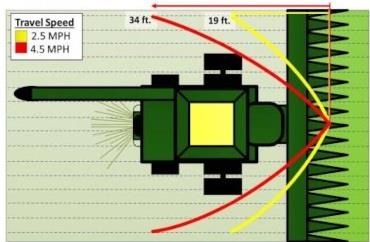By Ryan Bergman
With harvest quickly approaching, it’s time to make sure your combine is prepped and ready for the field. This article published in fall of 2020 has some good tips for calibrating your yield monitor to ensure high quality yield data. If you are going to harvest test plots or other strip trials with your combine, there are some additional steps you should consider to ensure high quality data from test plots.
Evaluate the Status of your Yield Monitor Components
Many growers harvested downed crops because of the 2020 derecho. While we recommend inspecting your combine and its yield monitoring components every year, it may especially important this year for many. Debris in fields in 2020 (like metal from buildings, wood, etc.) as well as crops with more dirt due to being downed may have prematurely worn components on your machine and could cause your yield monitor accuracy to be impacted.

Figure 1. Yield sensors damaged by dirt or other debris must be replaced and data collected with damaged sensors should be removed from analysis.
Inspecting critical components like the impact plate, clean grain elevator paddles and chain tension as well as the crop moisture sensor to ensure they are in good condition and ready for harvest will help produce high quality yield data. It’s important to remember that any adjustments made to the clean grain elevator chain tension will impact how crop hits the yield monitor impact sensor and is cause to recalibrate the yield monitoring system.
Calibrate the Yield Monitoring System
Ensuring the combine has a good multi-point calibration is a key first step to ensuring accuracy. Make sure the speed and yield of the crop being harvested in your trial area is similar to at least one point included in your multi-point calibration. This ensures the flow rate the machine will be operating at while harvesting your trial has a similar, scale verified calibration point. It’s also important to do multi-point calibrations with weights from a well-calibrated grain cart or weigh wagon.

Figure 2. As corn moisture increased, yield monitor accuracy decreased. This is a primary driver for the importance of recalibrating yield monitors.
Crop moisture is often the biggest culprit of errors in yield monitoring systems. Ensure the multi-point calibration being used was developed with crop of similar moisture. Moisture differences of as little as 2.5% could cause yield measurement errors of up to five percent. For step-by-step information on calibrating your combine’s yield monitor, the Iowa State University’s Digital Ag team provides an online interactive monitor guide.
Understand the crop flow delays within your machine
If harvesting continually through a strip trial or check block in a field, it’s important to understand delays in crop flow that are inherent with combine harvesters. On average, it takes about 13 seconds for grain to get from the combine head to the mass flow sensor. This delay depends on a variety of factors, such as header width, ground speed and the type of crop being harvested. Most commercial yield monitors attempt to correct for some of this delay in the display. By verifying that your GPS offsets and other machine parameters are properly set up, you can ensure the display will correct for this to the best of its ability. Failure to properly set up your display could result in the test block or strip trial not lining up correctly with other data sets, making analysis difficult.

Figure 3. As the combine continues to travel through the field, large amounts of grain are averaged to create a single data point. This increases with harvest speed. With a 40-foot corn head traveling at 2.5 miles per hour, grain from about 19 feet of forward travel distance is being merged to create a single data point. As speed increases to 4.5 miles per hour, the distance increases to 34 feet of travel.
It’s important to also understand that crop from the outside of the head takes longer to reach the feeder house than rows near the center of the head. This results in crop being merged along the forward travel distance of the combine. This distance changes based on header width and travel speed, shown in Figure 3. Consider this when harvesting field trials and plots. If continually harvesting through multiple plots, it will take a significant distance for all the grain from the first plot to pass by the yield sensor before you are completely measuring only grain from the second plot. When harvesting field trials, it’s recommended that a plot length be no less than 100 feet to account for this delay and collect the most accurate data. For more information on how this can affect yield data, see our spring article on setting up field trials.
Be wary of data from crop damaged fields
If harvesting crops from a field with wind or other damage that impacts your harvesting speed, caution must be taken when analyzing data. If your combine is speeding up and slowing down as it travels through a field, or for different crop varieties that have differing levels of damage, the associated yield data could be biased if machine flow rates are outside the flow rates you calibrated for. Additionally, if fields have extreme damage, any trial data from that field may not be accurate or representative of a typical year. You will have to decide whether to include it in any trial analysis, as well as whether to include the field as a whole in your continuing multi-year yield analysis.
The information discussed above is in regards to harvesting continuously through field trails or plots. The best way to get absolute data from test strips is to harvest all the grain from the test pass and weigh it in a calibrated grain cart or weigh wagon. Accurate yield data can be highly valuable for improving crop management and input decisions on your operation, but it needs to be a year-long practice to reap the full benefits. As new technology and automation tools continue to develop and become more hands-off for operators, it’s important to continue paying close attention to your data collection systems to quickly address any issues and ensure useful and insightful analytics. Ask for help as needed from local extension professionals or others in ag retail who can help you prepare in a way that results in high quality data.
Source : iastate.edu